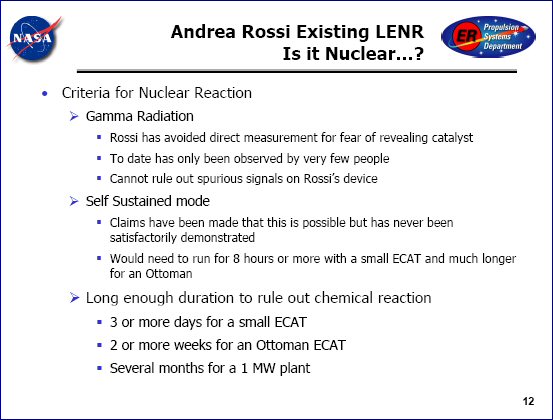NASA Engineer Explains Why Rossi Demos Failed
According to a slide presentation given by NASA engineer Michael A. Nelson, which New Energy Times obtained under a FOIA request, “Energy Catalyzer” inventor Andrea Rossi failed to conclusively show that his device produced excess heat from a nuclear energy source.
According to Nelson, a NASA engineer who investigates low-energy nuclear reactions and space applications, Rossi did not run his demonstration long enough to prove his extraordinary claim.
At the Sept. 22, 2011 LENR Workshop at NASA Glenn Research Center, Nelson explained that Rossi “would need to run [his experiment] for eight hours or more with a small E-Cat and much longer for an Ottoman [Fat-Cat] to rule out a chemical reaction.”
According to Nelson, it would take “three or more days for a small E-Cat, two or more weeks for an Ottoman [Fat-Cat] E-Cat and several months for a 1 MW plant.”

Brian Ahern, a researcher with expertise in LENR, wrote to New Energy Times with a concise summary of the recent Oct. 28 Rossi demo:
“Rossi has been clever enough to change the trick on each successive demo. Using a secret customer is a great way to allow him to fulfill his promise to demo the 1 MW unit in October. He then evaded conducting the demo transparently by saying that the customer demanded the demo conditions. The “customer’ signed off when Rossi gave him the wink and he shut things down without any measurements by anyone except the shill.
“Occam’s Razor, on the other hand, says that 12 inconclusive demos in succession are not random. It is well planned and orchestrated. He has used the journalists like a team of puppets.”

